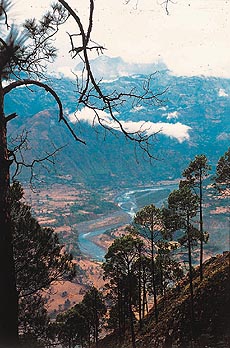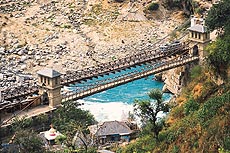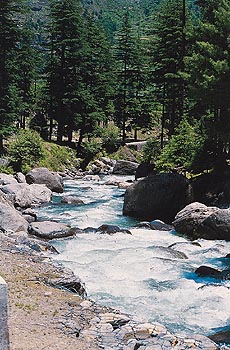










 








 

 |
Rhapsody
along rivers
By Rajnish
Wattas
Hills of the North,
rejoice:
Rivers and mountain-spring.
Hark to the advent voice!
Valley and lowland, sing!
—
Charles E Oaklay!
DO rivers sing? I think they do,
if you listen to them. In my rambles along rivers, I have
savoured their sounds — ranging from turbulence to
or even a mystic, silence.
 Rivers
have their moods. They can be noisy and bubbly like a
hill stream or lazy and languid, when in the plains. You
strike a sympathetic chord with their tumult and
travails, as they carve their ways through arduous,
narrow gorges and steep crevices, to come down thundering
as water falls. And then a gentle musical trill in the
meadows. Rivers
have their moods. They can be noisy and bubbly like a
hill stream or lazy and languid, when in the plains. You
strike a sympathetic chord with their tumult and
travails, as they carve their ways through arduous,
narrow gorges and steep crevices, to come down thundering
as water falls. And then a gentle musical trill in the
meadows.
Their colours also
change. They can be pure white, crystalline waters in the
higher ranges and muddy and turbid in the plains. Strike
a camaraderie with these nature’s watery delights
and you not only discover yourself anew; but also the
perennial river of life.
Like many others, I have
often taken the river routes — even if a little
longer — on my voyages of discovery in the hills, as
they are always more panoramic. And have been rewarded
with the rhapsody which only river rambling can provide.
My most memorable
journey has been along the Sutlej. The legendary
Hindustan-Tibet road in Himachal Pradesh hugs the
riverbank for many miles. As one crosses Kumarsain along
this highway, just before Rampur Bushair, one gets the
first glimpse of the river. It slinks its way through
hills that are almost denuded; its waters are muddy, but
the flow is rapid. Also, one is rewarded by the sight of
numerous hill torrents and water falls, disgorging their
waters into the majestic  river. At one point, you see huge
giant-sized boulders settled right in the middle of the
river, slicing its flow. But the most awesome sight is
after you cross Juree, whence the road detours to the
pristine Bhimkali temples. There the Sutlej passes
through a deep gorge. Stop the car and look down at the
silvery waters of the river; it glides and meanders its
way, like a huge serpent. Face-to-face with such awesome
might of nature, man indeed looks puny. When you take the
wheel again, make sure not to look towards the steep
gorge, lest you get vertigo! river. At one point, you see huge
giant-sized boulders settled right in the middle of the
river, slicing its flow. But the most awesome sight is
after you cross Juree, whence the road detours to the
pristine Bhimkali temples. There the Sutlej passes
through a deep gorge. Stop the car and look down at the
silvery waters of the river; it glides and meanders its
way, like a huge serpent. Face-to-face with such awesome
might of nature, man indeed looks puny. When you take the
wheel again, make sure not to look towards the steep
gorge, lest you get vertigo!
The Beas in contrast has
one of the purest white waters; at least till it reaches
Aut valley, beyond Bhuntar. As its origin is the high
altitude Beas Kund glacier, on the road to the Rohtang
Pass, its waters are crystal clear, emanating from the
molten snows. Gradually from a hill stream, it widens
into a beautiful river at Manali. Wading its way through
strewn boulders and dense forests, it is very
picturesque, notwithstanding the garbage littering hordes
of tourists. The drive from Manali to Naggar along its
banks is one of the most beautiful as it passes through
apple orchards and old timber and slate-roofed hamlets.
And when it enters into the plains of Punjab, it bloats
into a wide ocean of muddy waters with islands and
sandbars dotting its course.
 Both the Beas and the Ravi take
birth from the high peaks of the Pir Panjal range. If
Kulu is the gift of the Beas, then Chamba is a gift of
the Ravi. To savour the beauty of Ravi, it is best to
drive along it, from Banikhet to Chamba. The road
serpentines through large valleys, dotted with terraced
paddy fields and pine forests. But it stays along the
deep blue waters of the Ravi, often clouded with mists
and haze; especially if it has just rained. On the way
you run into numerous small shrines of hill devtas
and devis, lifting you to the lofty plane of
nature and gods. But you also come across plenty of hill Dhabas,
enabling you a much welcomed cup of tea, and also a pause
to soak in the splendour of the river. It is never in a
hurry, and seems to contemplate its course of journey
from the sky-touching peaks to a confluence with the
infinite sea. Both the Beas and the Ravi take
birth from the high peaks of the Pir Panjal range. If
Kulu is the gift of the Beas, then Chamba is a gift of
the Ravi. To savour the beauty of Ravi, it is best to
drive along it, from Banikhet to Chamba. The road
serpentines through large valleys, dotted with terraced
paddy fields and pine forests. But it stays along the
deep blue waters of the Ravi, often clouded with mists
and haze; especially if it has just rained. On the way
you run into numerous small shrines of hill devtas
and devis, lifting you to the lofty plane of
nature and gods. But you also come across plenty of hill Dhabas,
enabling you a much welcomed cup of tea, and also a pause
to soak in the splendour of the river. It is never in a
hurry, and seems to contemplate its course of journey
from the sky-touching peaks to a confluence with the
infinite sea.
Near Chamba town it is
adorned with an old steel bridge, giving the city its
most conspicuous landmark. Later at night, when I was
musing in my snug, warm bed of the PWD resthouse, located
right on the banks of the river, I could hear its gentle
roar.
Yes, the sound of rivers
always stays with me. It’s a rhapsody which drowns
the tumult of mundane life.
|

